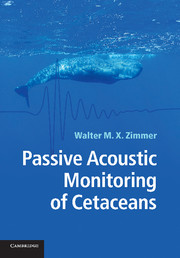Book contents
- Frontmatter
- Contents
- Acknowledgements
- Introduction
- Part I Underwater acoustics (the basics)
- Part II Signal processing (designing the tools)
- 4 Detection methods
- 5 Classification methods
- 6 Localization and tracking
- Part III Passive acoustic monitoring (putting it all together)
- References and further reading
- Index
6 - Localization and tracking
Published online by Cambridge University Press: 26 April 2011
- Frontmatter
- Contents
- Acknowledgements
- Introduction
- Part I Underwater acoustics (the basics)
- Part II Signal processing (designing the tools)
- 4 Detection methods
- 5 Classification methods
- 6 Localization and tracking
- Part III Passive acoustic monitoring (putting it all together)
- References and further reading
- Index
Summary
The capability to localize and track animals in space is an important function of PAM, as it allows behavioural analysis also by acoustic means. Well-known techniques for passive range estimation are multi-hydrophone ranging, triangulation, multi-path ranging and beam-forming. Tracking finally plays an important role if one not only tries to localize acoustically active cetaceans but also tries to monitor their behaviour. For this, it is necessary to determine continuously the location of each animal, that is, to track the individuals.
The localization of sound sources requires multiple independent measurements. These measurements may stem from multiple sensors that cover large areas and are therefore suited for multi-hydrophone ranging, or are based on qualitatively different measurements, e.g. multi-path time delay and angle of arrival estimation, as used in triangulation and multi-path ranging.
In general, one can say that for any unknown parameter, e.g. range, depth, bearing, one needs at least one independent measurement. Multiple measurements, however, may or may not be independent; depending on the geometry of the hydrophones relative to the acoustically active object closely spaced hydrophones tend to provide correlated, highly dependent measurements.
In principle, there are two complementary methods for localization, one based on the estimation of time delays, and the other based on beam-forming. Time-delay-based localization uses travel-time delays that occur when different hydrophones are found at different distances from the sound source, and is commonly used with widely spaced hydrophones.
- Type
- Chapter
- Information
- Passive Acoustic Monitoring of Cetaceans , pp. 198 - 236Publisher: Cambridge University PressPrint publication year: 2011

